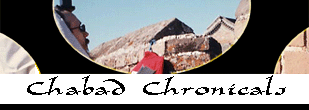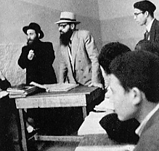Home
Letters
Article
Pictures
Soul Meetings
About
Contact

The Rebbe's
first emmisary

Morocco 1950
The period of World War Two marked a transition for world Jewry including the Lubavitch followers. Before the war, the majority of the Lubavitch followers were concentrated in Russia and Poland. Those who survived the Nazis and were able to obtain the necessary documents, settled temporarily, in France. From there they generally made their way to the United States or the land of Israel.
One of the followers, Rabbi Michael Lipskier, who then resided in France, consulted Rabbi Josef I. Schneersohn, the previous Lubavitcher Rebbe as to where he should settle. The Rebbe prepared an answer for him shortly before he passed away on January 28 1950. However, before the answer was sent to Rabbi Lipskier, the Rebbe passed on.
Ten days after the Rebbe’s passing, the Rebbe’s son in law, Rabbi Menachem Mendel Schneersohn (who later to became the Rebbe), informed Rabbi Lipskier in a letter that one of the last subjects his father in law discussed with him was the educational needs of the Jews in Africa. It is your mission to build Jewish life there, is my father-in-law’s message for you.
Rabbi Lipskier was puzzled by the answer. Africa was enormous and the letter had not mentioned any country in particular. Furthermore, at the time Africa was controlled by British and French colonial governments which demands to see a letter of invitation from a resident before a foreigner could settle. Rabbi Lipskier knew no one on the entire continent.
He told a number of his friends of his dilemma. One of them mentioned that Rabbi Boruch Toledano, Chief Rabbi of the city of Meknes, Morocco, was visiting France and would probably be happy to help him in whatever way possible. Through his influence, Rabbi Lipskier was invited to settle in Meknes.
Rabbi Lipskier's arrival shocked the town's inhabitants. He came by cab and many of them had never seen a car. Furthermore, his dress and mannerisms were strange. Rabbi Lipskier, in turn, was not used to the Moroccan dress, the way they sat on the floor, the way they prayed, etc. He immediately promised that he would induce Jewish tradition and customs based on the Sephardic tradition.
When Rabbi Lipskier inquired about the religious life in the town, he found that there was no Yeshiva. Immediately he hired carpenters to build tables and benches and asked Rabbi Toledano’s permission to use the shul. The Yeshiva attracted over 75 young students all of whom welcomed the opportunity to discover their Jewish heritage.
Many could not even read Hebrew. Those who could had only a rudimentary knowledge of Judaism. Rabbi Lipskier set up a program where the students could gain a working knowledge of the Bible and Jewish law and a taste of the Talmud. He inspired them with the spirit and warmth of Judaism, as well as providing them with food, lodging and medical attention.
Within a very short time, the Yeshiva gained renown throughout Morocco. Jewish leaders from other cities began turning to Rabbi Lipskier for help. Leaders of Myparst, a village four hours from Meknes, asked him to start a Talmud Torah. When he arrived, the children could not read. He organized a school, brought in teachers, and visited from time to time. A year later, one of his students celebrated his Bar Mitzvah, reciting the prayers on the Shabbat flawlessly. The townspeople began to treat Rabbi Lipskier with a new respect for a man foreign to them. He established summer classes for those who attended public and non-religious schools.
His personal courage and determination overcame much initial opposition to his plans. The youth welcomed the opportunity and at-tended in great numbers. They were inspired by the vitality and warmth of Judaism and became the vanguard in spreading the observance of Jewish tradition throughout Meknes.
In addition, Rabbi
Lipskier built a Tefillin factory, where the students learned how to make
Tefillen, which he then distributed among the local Jews. He constructed
a Matza bakery, to make the unleavened bread for the holiday of Passover
and restored the Mikva – the ritual bath used by Jewish women. As
a professional slaughterer he also introduced new techniques of ritual
slaughter.
For additional pictures please click here
additions please E-mail us